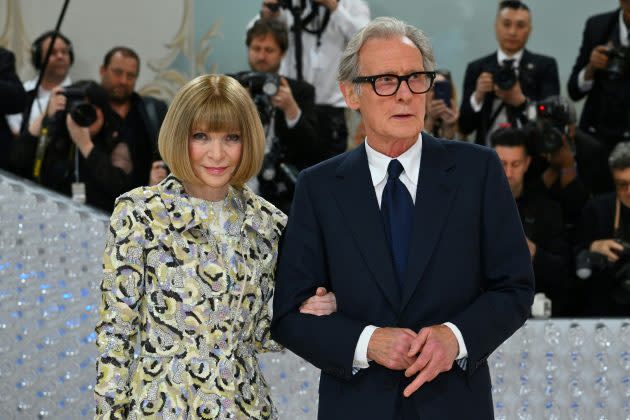Condé Nast Casts Itself as Arbiter of Culture at New Front Presentation

Condé Nast executives spent an hour and 10 minutes selling media buyers on their access to and position at the pinnacle of culture at its NewFront presentation in Manhattan on Thursday.
In fact, a succession of executives — including global chief revenue officer Pam Drucker Mann; global chief content officer Anna Wintour; Vogue European editorial director Edward Enninful, and Vanity Fair editor in chief Radhika Jones — said the word “culture” so many times, if the audience was playing a drinking game, they would have been falling off of their chairs 20 minutes into the show.
More from WWD
Standout Fashion Looks From the 2022 Vanity Fair Oscar Party
Standout Red Carpet Looks at Vanity Fair's 2022 Young Hollywood Party
“We don’t just make content, we make culture,” said Mann, as she boasted of 300 new social originals and pilots across more than 55 brand channels in 11 countries.
The presentation — on the 65th floor of The Spiral, the terraced mirrored skyscraper the occupies a city block in the canyons of Hudson Yards — was heavy on video snippets of Vogue’s most recent Met Gala and last year’s inaugural Vogue World event, which featured Little Nas X, Serena Williams, the Hadid sisters and stunt cyclists and the Howard University dance team, and kicked off New York Fashion Week. Enninful revealed, in typically soft-spoken fashion, that this year’s Vogue World would take place in London, in Covent Garden, on Sept. 14.
“The pandemic cast a long shadow over the arts,” Enninful told the room full of media buyers, adding that 100 percent of Vogue World ticket sales would benefit performing arts charities in London. BAFTA-winning film and theater director Stephen Daldry will helm the event which, like the New York show, will coincide with Vogue’s hefty (although less than it used to be) September issue and also kick off London Fashion Week.
Next year’s Vogue World will be in Paris, the site of the 2024 Summer Olympics, before moving to Asia and then back to the U.S.
The invention of Vogue World — a fashion show/street festival/multimedia event vaguely reminiscent of Vogue’s Fashion’s Night Out of years past — was an undeniable win for Wintour at a time when she has endured whispers about the calcification of the U.S. flagship and rumors of discord with Enninful, whose British Vogue has emerged as a zeitgeist-y hit in the Condé Nast firmament.
“Our editors have spent so much time at fashion shows over the years and around the world. Our idea was, why not make one with Vogue’s footprint?” explained Wintour. “It would also be a companion to our September global content, but most importantly, a new way for us to look at creating content with Vogue’s editorial sensibility and our particular point of view.”
Vogue World, she said, “Was a reminder how fashion and culture are one and the same and that Vogue is often at the center of both. We had a live stream that reached millions and a dedicated e-commerce site that allowed Vogue readers to shop runway looks in real-time.”
Vogue World also is an example of the kind of content that Condé Nast can actually scale and monetize amid declining digital ad revenue and when TikTok influencers have usurped legacy media’s gatekeeper status. Enninful noted that this year’s event — which will feature the best of London’s creative community including theater, dance and music — will be “an opportunity for us to make an enormous amount of content.”
Handled strategically, Vogue World could become a second tentpole along with the Met Gala, which has become Vogue’s biggest live video event. Last year’s Met Gala content notched 14 billion impressions, according to Mann.
And the immediacy and reach of exclusive celebrity festooned events — including Vanity Fair’s Oscar party and GQ programming around sporting events, including the Super Bowl — was a major talking point throughout the presentation.
Stressing the FOMO-ness of live originals, Agnes Chu, president of Condé Nast Entertainment, introduced a handful of new series including: Vanity Fair’s “A List with Franklin Leonard,” an interview program hosted by The Black List creator and VF contributing editor; “Vogue Final Fitting,” which follows celebrity brides during their final wedding dress fitting and was inspired by TikTok influencer Sofia Richie’s much-consumed posts about plans for her lavish wedding; “Home At Last,” an Architectural Digest-branded five-episode series that follows “Queer Eye’s” Tan France as he builds his dream home in Salt Lake City; Bon Appétit’s “Street Eats,” featuring Nice Day chef Lucas Sin in search of Hong Kong’s best street, and “The Mort Report,” which has street style influencer Mordechai Rubinstein, aka Mister Mort, conducting man-on-the-street interviews for GQ.
The company also has 230 returning series including “Vogue’s Beauty Secrets,” GQ’s “10 Essentials,” Wired’s “Autocomplete Interview” and AD’s “Open Door.” Chu noted that these four series generated more than 700 million video views last year.
That Condé Nast executives are pitching a legacy print company as the original influencer at a time of faltering advertising revenue is not surprising. And the company is sitting on a surfeit of IP, if only it could be captured, scaled and interpreted for a new generation. Mann stressed that 40 percent of the company’s digital audience is Millennial and Gen Z. When she introduced the 73-year-old Wintour, she characterized the longtime editor of Vogue (who has been atop the masthead since 1988) as “the living embodiment of how Condé Nast creates culture.”
For Wintour, the trick will be to keep doing it in a language that the TikTok generation speaks.
Best of WWD

